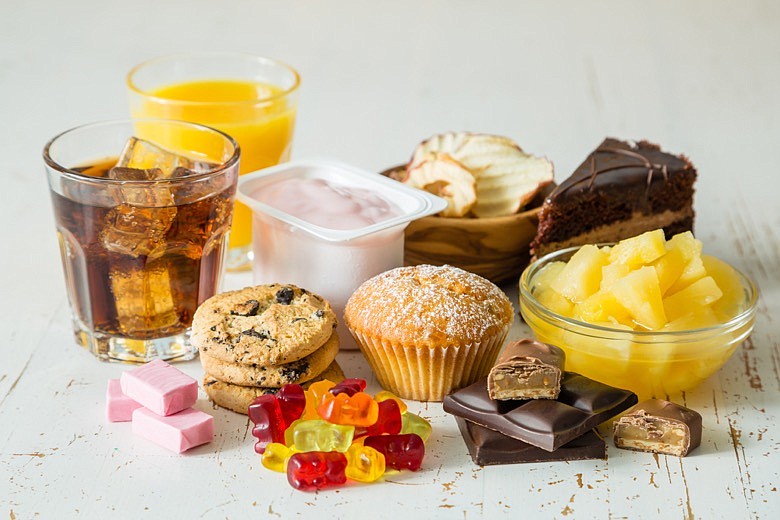A cookie every now and then or piece of pie is OK, but we Americans really need to give our sweet tooth a good flossing. The average American consumes more than 57 pounds of sugar every year, which translates into far more than the American Heart Association's recommended 37.5 grams (9 teaspoons) per day for men and 25 grams (6 teaspoons) per day per women.
"Sugar adds unnecessary calories, can increase inflammation in the body, can damage a healthy gut environment, can feed infection and can lead to poor oral health," says Danielle Townsend, a registered dietitian with Primary Health Care Center.
Now that all packaged foods come with a list of ingredients, it's easier to tell how much sugar we're consuming. If sugar is included on the list, it's broken down into two parts - natural and added sugar. You may think natural sugars are OK, and they are - in moderation.
"Fruit, milk, yogurt and grains all contain natural sugars and other beneficial nutrients," Townsend says. "The key is portion control and knowing what the serving goals are for each food group. The new food label now differentiates between natural sugar and added sugar, and I think this will be very beneficial and eye-opening for people. There is no recommended limit on natural sugars, but because sugar is a carbohydrate, the recommended goal is to get no more than half of your calories from carbs, or about 250 grams of carbs for a 2,000-calorie diet."
Added sugars may be lurking in foods you think may be low in sugar, such as ketchup; granola and other cereals, even whole-grain ones; and dried fruits, along with pasta sauces, crackers and pizzas, to name a few. And we've heard how good green tea is for us, but don't be fooled. Starbucks' Matcha Green Tea Creme Frappuccino has more than 15 teaspoons of sugar - and that's not counting the whipped cream.
Another big part of the problem is the high-sugar content of most processed foods, such as cookies, crackers, cakes and pies, but that's pretty well-known. Still, it remains a problem that many Americans haven't tackled. Just be sure to turn the package over and see what you're getting.
"The nutrition-facts label tells us the content of our food and beverages," Townsend says. "Ingredients are not hidden; people may just be confused as to what they are reading. If you're looking at the ingredient list, sugar can come in other names like brown sugar, corn sweetener, corn syrup, dextrose, fructose, glucose, high-fructose corn syrup, honey, invert sugar, lactose, malt syrup, maltose, molasses, raw sugar, sucrose, trehalose and turbinado sugar."
So what should we be eating? Townsend recommends low-sugar fruits such as berries and melons, along with vegetables and proteins, such as meats and beans.
Following a diet low in sugar is good for all of us.
"It's actually recommended for everyone," Townsend continues. "No one needs a high-sugar diet. People with diabetes and those desiring weight loss typically fare better in their efforts by moderating total carb intake. We should specifically limit carbs from sources like fast food, sweets and sugar and pull from fruit, vegetables, low-fat dairy and whole grains."
How can you follow a low-sugar diet and still treat yourself to a sweet every now and then? Fortunately, there's a wealth of artificial sweeteners on the market, including stevia, a natural sweetener. But beware of honey. Once it's in your body, your system will metabolize it like any sugar.
"Artificial sweeteners can be useful to help you transition from a heavy sweet tooth to a more controlled one," Townsend says, adding a warning: "Prolonged consumption of artificial sweeteners or sugar-free items could possibly perpetuate a heavy sweet tooth, disrupt your metabolism and create an unhealthy gut environment.
What's her best advice for pulling that sweet tooth and starting a low-sugar life?
"As with any new change, it takes persistence and commitment. You will undoubtedly experience cravings for your favorites, but I recommend using a tablespoon of peanut butter, fruit, yogurt or much smaller amounts of sweets to get through it."
When the craving hits, here's another good idea.
Low-Sugar Salted Banana-Chocolate No-Churn Ice Cream
6 medium bananas, sliced and frozen
1/2 cup milk of choice, such as unsweetened soy milk
1/4 cup unsweetened cocoa powder
1/4 cup dark chocolate chips
1/2 teaspoon sea salt or pink Himalayan salt
1/4 teaspoon vanilla extract
In a food processor or blender, combine all ingredients except for chocolate chips, and process until smooth. Add half of the chocolate chips, and pulse until combined.
Transfer ice cream into a freezer-safe container, and mix in remaining chips. Cover to prevent freezer burn, and freeze for at least 30 minutes, allowing the mixture to solidify for more ice-cream-like consistency.
Email Anne Braly at abraly@timesfreepress.com.

